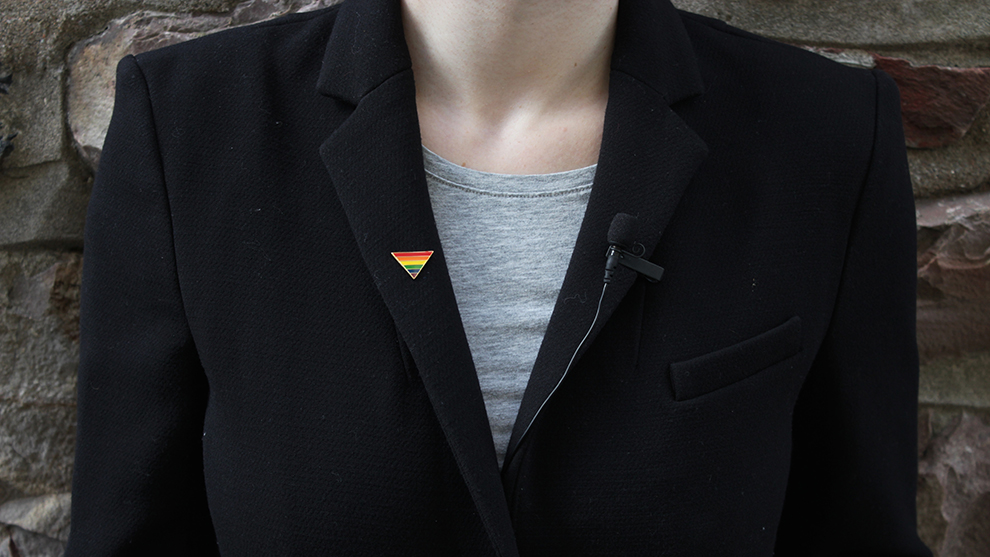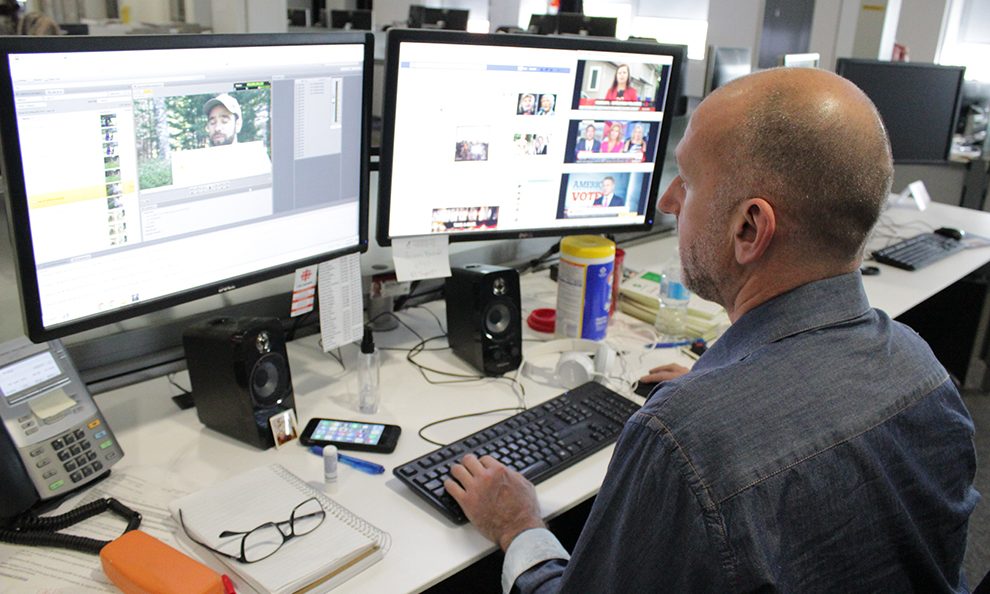Out in the newsroom

caption
How LGBTQ journalists navigate the workplace
Paul Émile d’Entremont was walking through the Halifax CBC-TV building and happened to hear a colleague talking animatedly to a few others. The co-worker’s voice was loud, exaggerated and effeminate.
D’Entremont thought, “Oh my god, he’s imitating me.” It was clear to him that the imitation was a slur on his sexual orientation. He felt jarred and humiliated; he thought his workplace was a safe space.
That was approximately 15 years ago. Today, d’Entremont believes there is zero tolerance at the CBC for discrimination. He is a producer at CBC/Radio-Canada and has worked there for almost 25 years; he was out at work before he came out to certain family members. The people in the Halifax office are his co-workers and friends. The soft, persistent clack of fingers on keyboards resonates comfortingly through the newsroom.
Workplace diversity is a popular term. Diversity is where race, ethnicity, religion, age, sexual orientation and gender identity intersect. If newsrooms consist of straight, white, cisgender employees, then they are not representing the diverse communities that make up their audiences. (See a list of LGBTQ terminology below.)
Many LGBTQ journalists believe there is a proportionate lack of LGBTQ employees in the newsroom, especially when it comes to transgender and non-binary people. Discrimination can still happen – as it did for d’Entremont – but LGBTQ journalists tend to speak about subtler things: crass jokes, misgendering, tokenization, and a lack of opportunities.

caption
Paul Émile d’Entremont works at his desk at CBC Radio-Canada in Halifax. D’Entremont experienced discrimination 15 years ago, but says he feels comfortable in the workplace.Not even a bump in the graph
As night editor for the Times newspaper in Scotland, the daily news makes Katherine O’Donnell groan inwardly. “Things look pretty grim all over the world,” she says.
Thirteen years ago, O’Donnell came out in the workplace as transgender. After briefing senior staff, she sent an email to co-workers explaining when she would transition; when employees received the email, the newsroom went silent. After she transitioned some co-workers wouldn’t look at her unless necessary. Once, two senior executives made a joke about trans people when O’Donnell was the only other person in the room.
The social atmosphere has changed, but O’Donnell believes the United Kingdom needs more transgender journalists. As far as she knows, she is the only trans journalist at a senior level in the national press. There are freelancers, but nobody on staff. “There’s really not enough representation for us to be a blip in a statistic,” O’Donnell says. “We wouldn’t make a bump in the graph.”
Erica Lenti, the new editor of This Magazine in Toronto, works for an inclusive publication – throughout its 50 years, many LGBTQ people have cycled through as contributors and staff – but she knows from past experience what it’s like to be the only LGBTQ journalist in a newsroom. She also knows what it feels like to be tokenized. In more than one workplace, if there was a story about an LGBTQ issue colleagues immediately sought out Lenti and assumed she would know everything about it. She doesn’t like to think of herself as a “queer journalist”; she knows she is more versatile than that. First and foremost, she is a journalist.
For Lenti, tokenization is problematic because there are various identities under the umbrella term LGBTQ. She has turned down stories about certain issues because she doesn’t represent the people they affect. “If I’m not part of that community,” Lenti says, “I definitely don’t want to speak for them.”
Sidney Drmay, an English student at Ryerson University and the communities editor for the Eyeopener, Ryerson’s independent student newspaper, identifies as transgender and non-binary. As far as Drmay knows, there are no other queer people in the newsroom.
Drmay often volunteers for LGBTQ stories out of a wish to have them told by someone connected to the LGBTQ community. Drmay writes a lot about discrimination on campus, and spends time listening to students talk about their experiences. Sometimes, it can make Drmay feel emotionally drained. “I’ve already had to live someone else’s trauma through their words. I don’t want to go experience my own.”
Watch your language
The Canadian Press Stylebook does not have a section on non-traditional or gender-neutral pronouns. Some newspapers, like the Washington Post, have added the gender-neutral pronoun “they” to their style guides.
GLAAD (formerly the Gay & Lesbian Alliance Against Defamation), a New York-based NGO, has published the GLAAD Media Reference Guide, which suggests journalists ask what pronouns people use to describe themselves. Andrea Houston, who teaches a queer media course at Ryerson University in Toronto, believes using proper pronouns is a matter of human rights. “It’s not your job as a journalist to debate their identity,” she says.
Charles Lewis, a former religion editor at the National Post, disagrees with gender-neutral pronouns. “Just because a few people carrying signs demand it does not mean you change the English language.”
According to the Williams Institute – a UCLA think tank conducting research on sexual orientation and gender identity – there are approximately 1.4 million trans adults in the United States. Marc Lachance, director of the demography division of Statistics Canada, told CBC News in September 2016 that to his knowledge there are no national surveys collecting data on the Canadian transgender population.
Drmay has repeatedly told Eyeopener co-workers to use gender-neutral pronouns. “Half of them are on top of it,” but the other half often misgender Drmay. Occasionally co-workers will catch themselves, but for the most part they forget. A few weeks ago, Drmay says one co-worker realized and apologized. “I didn’t have the heart to tell him he’d been doing it for months.”
Other blunders can happen in newsrooms, like the odd inappropriate comment or bigoted remark. Lenti, now of This Magazine, was on the receiving end of this earlier in her career. Once, a co-worker jokingly called her “dyke.” “It was super shitty,” says Lenti. She explained that the word was inappropriate – historically, it has been used as a slur. While some have reclaimed the word as a self-identifier, it is often offensive and can reinforce the stereotype that all lesbians are masculine.
Sarah Liss has worked full-time at Toronto’s Now magazine, CBC Arts, CBC Music, and the Grid; she is currently a senior editor at Reader’s Digest. As a queer woman, she felt supported and safe in most of these workplaces, but still heard the occasional crass joke.
Liss was so fed up with listening to gay clichés from one co-worker that she turned to literature for help: she left the Dictionary of Homophobia on her desk. “We hoped she would get the message,” Liss laughs. Another time, a colleague told an anecdote about how he snuck into a nightclub as a teenager and was shocked to find gay men there. Liss watched as he flamboyantly re-enacted the encounter. In retrospect, Liss asks incredulously, “How do you not recognize that what you’re doing is acting out a really harmful gay stereotype?”
Slow slog toward inclusion
The Canadian Centre for Diversity and Inclusion (CCDI) – a Toronto-based organization that advises employers on workplace diversity – published a national study in 2015 about discrimination against LGBTQ employees based on 1,410 respondents. The majority of heterosexual and cisgender respondents were unaware of discrimination against LGBTQ co-workers. Thirty-three per cent of LGBTQ respondents witnessed discrimination, and 29 per cent experienced discrimination.
In July, the results were published from a study commissioned by TELUS that surveyed 814 random Canadians. Almost half of respondents didn’t think their workplace was inclusive for transgender employees.
Gretchen Hammond, a journalist in Chicago, is trying to break into mainstream news. Hammond has a background in investigative, political, and social justice reporting, but as a transgender journalist working for Windy City Media Group – a LGBTQ news organization in Chicago – has found hardly any other employers interested in hiring her. Those who did respond were cynical.
“Their concern was ‘how can a LGBT journalist cover anything other than LGBT issues?’,” Hammond says. She thinks there is an incorrect belief that LGBTQ journalists will only write LGBTQ stories. To test this, Hammond tried an experiment. She sent two applications to one job. The only difference was that one of the two didn’t say she was transgender and didn’t include her LGBTQ articles. That application got a call back.
Gretchen Hammond talks about the struggles she has looking for a job
Hammond is still applying to newsrooms with, so far, no success. She might need to consider other options, such as communications or public relations. Doing so, Hammond says, “would break my heart.”
Overall it’s a slow slog toward newsroom inclusion. While there are traceable problems for LGBTQ employees – tokenization, inappropriate comments, terminology wars, and a lack of opportunities – in the end, inclusivity and diversity depend on individual newsrooms.
Fifteen years ago, d’Entremont experienced discrimination. Now he strolls around the newsroom greeting coworkers and cracking jokes. There is a warm energy that thrives on efficiency. Someone is using a fitness ball for a desk chair.
“If it’s an atmosphere of respect, then diversity will flourish,” says d’Entremont. “I sincerely believe that’s what happens here.”

